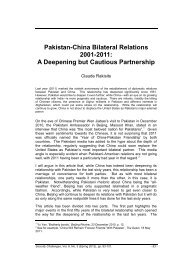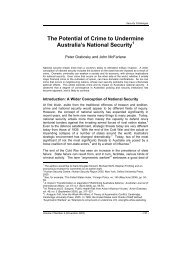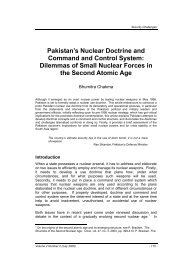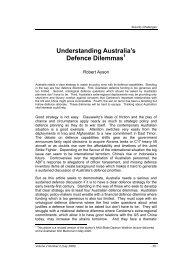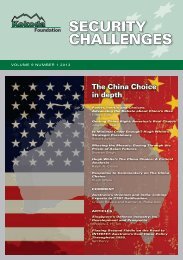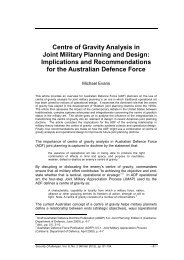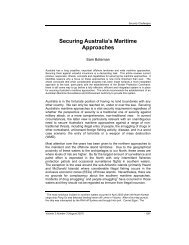The Transformation of Triad - Security Challenges
The Transformation of Triad - Security Challenges
The Transformation of Triad - Security Challenges
You also want an ePaper? Increase the reach of your titles
YUMPU automatically turns print PDFs into web optimized ePapers that Google loves.
Roderic Broadhurst and Lee King Wa<br />
criminal groups by their morphology. 19 Thrasher’s remarkable insights<br />
remain relevant: 20<br />
Although organized crime must not be visualized as a vast edifice <strong>of</strong> hard<br />
and fast structures, there is a surprising amount <strong>of</strong> organization <strong>of</strong> a kind in<br />
the criminal community. <strong>The</strong>re is a certain division <strong>of</strong> labor manifesting itself<br />
in the specialized persons and specialized groups performing different but<br />
related functions. <strong>The</strong>re are, furthermore, alliances and federations <strong>of</strong><br />
persons and groups, although no relationship can be fixed and lasting as in<br />
the organization <strong>of</strong> legitimate business. 21<br />
This paper addresses contemporary forms <strong>of</strong> triad-related crime in HK and<br />
we follow the Hong Kong Police (HKP) practice <strong>of</strong> referring to crime groups<br />
as ‘triad’ when self-nominated or when individuals associated with a crime<br />
group refer to themselves as a triad—including persons who may only be<br />
associates or may not be initiated if such rituals occur. <strong>The</strong> ‘Big Circle Boys’<br />
(Dai Huen Jia), for example, although initially formed from among mainland<br />
migrants to HK in the 1970s are referred to as either a criminal group or<br />
triad. Despite the absence <strong>of</strong> local background some Big Circle Boys were<br />
also ‘members’ <strong>of</strong> HK triads. 22 <strong>The</strong> term ‘triad’ or in colloquial Cantonese<br />
‘dark society’ is usually reserved for traditional HK crime groups or gangs<br />
who could be authenticated by triad experts <strong>of</strong> the HKP and recognised as<br />
such by the HK courts. 23 <strong>The</strong> authenticity <strong>of</strong> a criminal group’s triad<br />
connection or otherwise is usually opaque as is the extent <strong>of</strong> criminal activity<br />
among known triads. In jurisdictions such as HK, Macau, and Taiwan, triad<br />
association allows access to brand reputation and social capital so that a<br />
degree <strong>of</strong> overlap and ambiguity between triad society, illicit business and<br />
‘organised crime’ is inherent. 24 However, because HK and other Chinese<br />
19<br />
Levi, ‘<strong>The</strong> Organization <strong>of</strong> Serious Crimes’; P. C. Duyne and T. Vander Beken, ‘<strong>The</strong><br />
Incantations <strong>of</strong> the EU Organized Crime Policy Making’, Crime, Law and Social Change, vol. 51<br />
(2009), pp. 261-81. <strong>Triad</strong>s in HK and Macau are usually depicted as the only dominate forms <strong>of</strong><br />
organised crime that retain a ‘definable structure’: see for example, Parliament <strong>of</strong> Australia,<br />
Parliamentary Joint Committee on the Australian Crime Commission: Inquiry into the legislative<br />
arrangements to outlaw serious and organised crime groups (Canberra: Senate Printing Unit,<br />
August 2009), pp. 78-9.<br />
20<br />
K. F. Yu, <strong>The</strong> Structure and Subculture <strong>of</strong> <strong>Triad</strong> Societies in Hong Kong, M.Phil. (Hong Kong:<br />
City University <strong>of</strong> Hong Kong, July 1998). Yu drew on interviews with fifty prisoners drawn from<br />
three major triads: ‘Sun Yee On’, ‘14K’ and ‘Wo Shing Wo’ who described the degraded<br />
organisation and ritual. He classified them according to Thrasher’s notions <strong>of</strong> unity and<br />
cohesiveness noting that ‘Sun Yee On’ were more organised than the others.<br />
21<br />
Further, “[O]ne <strong>of</strong> the outstanding characteristics <strong>of</strong> the criminal community is what might be<br />
called its fluidity … there is no hard and fast structure <strong>of</strong> a permanent character” (p. 285), F. M.<br />
Thrasher, <strong>The</strong> Gang: A Study <strong>of</strong> 1,313 Gangs in Chicago (Chicago: University <strong>of</strong> Chicago<br />
Press, 1927) [1963 edition edited by J. F. Short], pp. 285-6.<br />
22<br />
A. Chung, ‘<strong>The</strong> Big Circle Boys: Revisiting the Case <strong>of</strong> the Flaming Eagles’, Global Crime, vol.<br />
9, no.4 (2008), pp. 306-31.<br />
23<br />
Ninety-three HKP <strong>of</strong>ficers are currently designated ‘triad experts’ with the addition <strong>of</strong> 23<br />
<strong>of</strong>ficers graduating from a recent course: ‘Welcome boost for <strong>Triad</strong> Expert Cadre’, Offbeat, issue<br />
887 (14 January-10 February 2009).<br />
24<br />
Chin, Heijin: Organised Crime, Business and Politics in Taiwan; T. W. Lo, ‘Beyond Social<br />
Capital: A Case <strong>of</strong> <strong>Triad</strong> Financial Crime in Hong Kong and China’, working paper, City<br />
University <strong>of</strong> Hong Kong, July 2009.<br />
- 4 - <strong>Security</strong> <strong>Challenges</strong>



